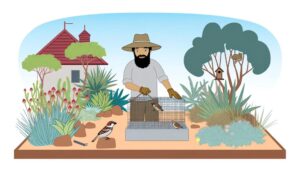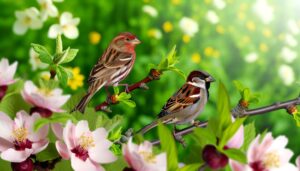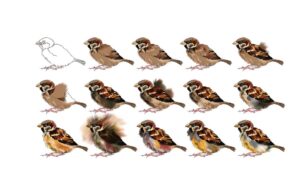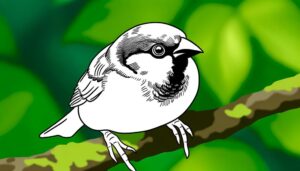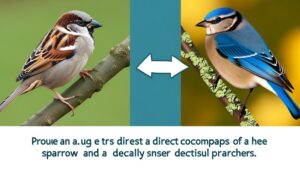5 Steps to Tame a House Sparrow – A Beginner’s Guide
Taming a house sparrow requires a structured approach. Start by setting up a peaceful environment with a spacious cage, varied perches, and toys.
Gradually introduce yourself by sitting quietly nearby to build trust. Opt for high-quality seeds and establish a regular feeding schedule, offering food from your hand to create positive associations.
Maintain a calm presence and use positive reinforcement to encourage desired behaviors. Observe the sparrow's body language to make sure it feels secure.
Consistent and gentle interactions, along with meeting the bird's environmental and nutritional needs, are essential for successful taming. For advanced insights, further details are necessary.
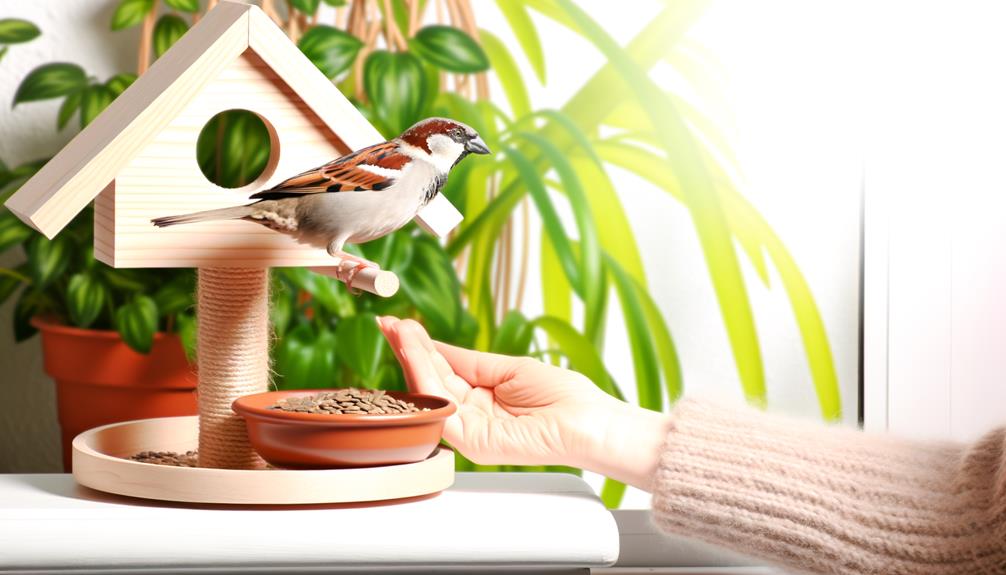
Key Takeaways
- Establish trust by sitting quietly near the bird's cage and maintaining a calm presence.
- Offer food directly from your hand to create positive associations and build trust.
- Create a predictable routine by performing actions at the same time each day.
- Use positive reinforcement by immediately rewarding desired behaviors with motivating rewards.
- Monitor the sparrow's body language to ensure it feels relaxed and reduce stress.
Understanding House Sparrows
House Sparrows (Passer domesticus), a species native to Eurasia, are small, social birds that have successfully adapted to various urban and rural environments across the globe. These birds exhibit sexual dimorphism; males possess distinctive black bibs and grey crowns, while females and juveniles are more uniformly brown.
Their adaptability is largely due to their omnivorous diet, consuming seeds, insects, and human food scraps. House Sparrows are also known for their complex social structures and vocal communication, which facilitate their interactions within flocks.
Understanding their behavior is essential for taming, as they exhibit both territorial aggression and cooperative feeding habits. Recognizing their natural history and social dynamics provides a foundational understanding necessary for successful interaction and domestication efforts.
Providing a Safe Space
Creating a safe and comfortable environment is crucial when attempting to tame a House Sparrow, as it minimizes stress and fosters a sense of security essential for building trust. Begin by selecting an appropriate cage size and location that guarantees ideal living conditions.
| Aspect | Consideration |
|---|---|
| Cage Size | Ample enough for free movement |
| Cage Location | Serene, low-traffic area |
| Perches and Enrichment | Diverse perch sizes and toys |
| Temperature Control | Steady, avoiding extreme fluctuations |
| Cleanliness | Regular cleaning to prevent disease |
Ensure the cage is placed in a serene, low-traffic area to reduce stress. Include diverse perches and toys to stimulate natural behaviors. Maintain steady temperatures and rigorous cleanliness to prevent health issues. This environment will provide a foundation for taming efforts.
Gaining Initial Trust
Establishing an initial bond with a House Sparrow involves patient and consistent interactions that prioritize the bird's comfort and autonomy. Begin by maintaining a calm and quiet environment to reduce stress. Minimize sudden movements and loud noises, which can trigger fear responses.
Gradually introduce yourself by sitting quietly near the sparrow's habitat, allowing it to observe you from a safe distance. Use soft, reassuring tones to familiarize the bird with your presence. Consistency in your approach is vital; repeated, gentle interactions will help the sparrow associate you with safety.
Monitor the bird's body language for signs of relaxation, such as preening or chirping, to gauge its growing trust. Patience and perseverance are necessary throughout this meticulous process.
Offering Food and Water
Initiating the taming process with appropriate nourishment requires selecting high-quality seeds that align with the dietary preferences of house sparrows.
Ensuring a consistent supply of fresh water is equally essential, as hydration plays an important role in their overall health.
Establishing a regular feeding schedule not only fosters trust but also conditions the sparrow to recognize feeding times, thereby facilitating closer interactions.
Choosing the Right Seeds
Selecting suitable seeds is crucial for providing ideal nutrition and ensuring the well-being of a house sparrow. Primary seeds that should be included in a sparrow's diet are millet, cracked corn, and sunflower seeds.
Millet, particularly white proso millet, is highly favored due to its small size and high nutritional content. Cracked corn provides necessary carbohydrates, supporting energy needs. Sunflower seeds, especially black oil sunflower seeds, offer essential fats and proteins necessary for overall health.
It is beneficial to offer a variety of seeds to mimic a natural diet and prevent nutritional deficiencies. Additionally, seed mixes specifically formulated for small birds can be a convenient option, ensuring a balanced diet and enhancing the taming process through positive reinforcement.
Providing Fresh Water
In addition to providing a balanced diet through appropriate seeds, ensuring access to fresh water is equally important for the health and taming of a house sparrow.
Fresh water is essential for hydration, digestion, and overall physiological functions. It is recommended to use a shallow dish with a depth of no more than 1-2 centimeters to facilitate easy access and minimize the risk of drowning.
The water should be changed daily to prevent contamination and the growth of harmful bacteria. Position the water dish in a quiet, accessible area to encourage frequent visits by the sparrow.
Monitoring the water supply and ensuring it remains clean will greatly contribute to the bird's well-being and foster a trusting bond.
Establishing a Feeding Schedule
Establishing a consistent feeding schedule is vital for maintaining the health and taming process of a house sparrow, as it promotes predictable behavior and fosters a sense of security.
Begin by offering food at the same times each day, guaranteeing the bird becomes accustomed to routine. A balanced diet is essential; include seeds, insects, and fresh fruits.
Morning Feeding: Provide a mix of seeds and fresh water to start the day.
Afternoon Snack: Introduce small insects or mealworms to diversify nutritional intake.
Evening Meal: Offer a combination of seeds and fruits to secure a well-rounded diet.
Monitor the sparrow's consumption patterns and adjust portions accordingly to prevent overfeeding or nutritional deficiencies.
Using Positive Reinforcement
Implementing positive reinforcement involves systematically rewarding a house sparrow for exhibiting desired behaviors, thereby increasing the likelihood of these behaviors being repeated.
Begin by identifying a highly motivating reward, such as specific seeds or insects. Once the reward is determined, observe the sparrow's behavior closely. When the desired behavior occurs, immediately offer the reward to create a clear association between the action and the positive outcome.
Consistency is important; make sure that rewards are given promptly and every time the behavior is observed. Over time, gradually introduce a cue or command before the behavior to strengthen the association.
This methodical approach not only fosters trust but also encourages the sparrow to engage in the targeted behaviors reliably.
Gentle Hand Training
Gentle hand training involves gradually acclimating the house sparrow to human presence and touch by using a systematic approach that emphasizes patience and consistency.
To achieve successful hand training, follow these steps:
- Offer Food from Your Hand: Begin by placing food in your palm and allowing the sparrow to approach at its own pace. This builds trust and reduces fear.
- Gradual Proximity: Slowly decrease the distance between your hand and the sparrow each day. Avoid sudden movements to prevent startling the bird.
- Light Touches: Once the sparrow is comfortable eating from your hand, gently touch its chest or head with a finger. Gradually increase the duration and firmness of these touches.
This systematic approach guarantees a stress-free experience for the sparrow.
Building a Routine
Establishing a consistent routine is essential for taming a house sparrow, as predictability enhances the bird's sense of security.
Regular feeding times should be implemented to create a structured environment, while gentle interaction practices help build trust.
Systematic repetition of these elements will facilitate the acclimatization process and foster positive behavioral responses.
Consistent Feeding Times
To nurture a sense of security and predictability in a house sparrow, it is crucial to maintain consistent feeding times as part of a structured routine. Establishing regular feeding intervals helps the sparrow to anticipate and feel secure in its environment. This predictability serves to reduce stress and promote trust.
Following a consistent feeding schedule can be achieved by following these steps:
- Set Specific Times: Choose two or three feeding times each day and strictly follow these intervals.
- Quantity and Quality: Guarantee that the food provided is consistent in quantity and nutritional quality.
- Environment: Sustain a calm and steady feeding environment to prevent startling the bird.
Following these guidelines will aid in the taming process.
Gentle Interaction Practices
Incorporating gentle interaction practices into your daily routine is essential for gradually building trust and familiarity with a house sparrow. Begin by maintaining a calm and consistent presence in the bird's environment, speaking softly to acclimate it to human sounds.
Gradually introduce your hand into the sparrow's space without sudden movements. Offer food directly from your hand, ensuring it associates your presence with positive experiences. Repetition is key; perform these actions at the same time daily to create a predictable routine.
Observe the sparrow's body language closely; signs of stress or fear indicate the need to slow down. Patience and consistency are vital, as this methodical approach fosters a secure and trusting relationship over time.
Recognizing Sparrow Behavior
Understanding the specific behaviors of house sparrows is vital for effectively taming and interacting with these small, social birds. Observing their actions can provide valuable insights into their comfort levels and needs. Key behaviors to recognize include:
- Feeding Habits: Sparrows exhibit pecking and foraging behaviors, often hopping to locate food. Noting their feeding times can help in establishing trust.
- Social Interactions: These birds are highly social and often engage in communal activities such as chirping and preening. Recognizing flock dynamics can aid in understanding their social hierarchy.
- Flight Patterns: House sparrows show specific flight behaviors when alarmed or relaxed. Observing their flight can indicate stress levels or comfort in their environment.
Understanding these behaviors is vital for successful taming.
Creating a Comfortable Environment
Establishing a comfortable setting for house sparrows involves meticulously arranging a habitat that mimics their natural surroundings while maximizing safety and accessibility to essential resources.
Begin by selecting a spacious enclosure with horizontal bars, allowing for natural perching and flight. Incorporate indigenous foliage and secure branches to replicate their natural habitat. Provide nesting materials such as dried grass and feathers to promote natural behavior.
Guarantee a consistent supply of fresh water and a balanced diet comprising seeds, grains, and occasional insects. Maintain ideal ambient temperature and humidity levels, mirroring their natural environment. Regularly clean the habitat to prevent disease and stress.
This systematic approach fosters a secure and engaging environment conducive to taming and well-being.
Handling With Care
In the process of taming a house sparrow, it is essential to employ gentle approach techniques to minimize stress and guarantee the bird's well-being.
Creating a stress-free environment through consistent and calm interactions can greatly enhance the taming experience.
Additionally, adhering to safe holding practices will prevent injury and foster trust between the handler and the sparrow.
Gentle Approach Techniques
Employing gentle approach techniques is essential for minimizing stress and ensuring the safety of both the handler and the house sparrow. The following steps provide a methodical approach:
- Approach Slowly: Gradually move towards the sparrow to avoid startling it. Sudden movements can induce fear, making the taming process more challenging.
- Use Soft Voices: Communicate with calm, gentle tones to build trust. Loud noises can cause anxiety, reducing the bird's willingness to engage.
- Handle with Minimal Contact: Initially, limit physical contact to avoid overwhelming the sparrow. Use a soft cloth to gently cradle the bird, ensuring a secure yet non-restrictive grip.
Stress-Free Environment
Creating a stress-free environment for a house sparrow requires meticulous attention to minimizing potential stressors and guaranteeing the bird's comfort and well-being.
Begin by providing a quiet, secure habitat away from loud noises and frequent human traffic. Utilize natural light sources and maintain a stable temperature within the enclosure to mimic their natural surroundings.
It's essential to offer perches of varying heights and materials to accommodate their instinctual behaviors. Guarantee that the cage is spacious enough to allow for free movement. Regularly clean the habitat to prevent disease and maintain a hygienic environment.
Additionally, avoid sudden movements and loud sounds when near the sparrow, as these can trigger stress responses detrimental to its taming process.
Safe Holding Practices
Securing a stress-free environment paves the way for effective and safe handling practices, which are critical for the well-being and taming of a house sparrow. Proper handling minimizes the risk of injury and stress.
Here are three key steps to follow:
- Gentle Approach: Slowly extend your hand, allowing the sparrow to see and acclimate to your presence. Sudden movements can cause panic.
- Secure Grip: Hold the sparrow firmly but gently, using your thumb and forefinger around its body, making sure you do not apply excessive pressure.
- Calm Environment: Conduct handling in a quiet, controlled setting to reduce external stimuli that may frighten the bird.
These practices guarantee the sparrow remains calm and builds trust, essential for successful taming.
Encouraging Social Interaction
Facilitating social interaction for a house sparrow involves mimicking natural behaviors and environments to promote comfort and engagement. To achieve this, create a habitat that includes elements such as perches, foliage, and nesting materials, replicating a natural avian environment.
Introduce the sparrow to gentle, consistent human presence, using a calm demeanor and soft voice to reduce stress. Offering small, frequent treats can serve as positive reinforcement, encouraging the sparrow to approach and interact. Additionally, mimic sparrow calls to foster familiarity and trust.
Gradually increase the duration and complexity of interactions, always observing the bird's responses to avoid overstimulation. This methodical approach enhances the bird's social comfort and lays a foundation for deeper human-avian rapport.
Long-Term Bonding Strategies
Establishing long-term bonding with a house sparrow requires a consistent routine of positive reinforcement, mutual trust-building activities, and attentiveness to the bird's evolving behavioral cues. This systematic approach enhances the bird's comfort and familiarity over time.
Regular Feeding Schedule: Maintain a fixed feeding time using high-quality seeds and occasional treats. This predictability fosters trust.
Gentle Handling: Gradually introduce gentle handling sessions, allowing the sparrow to associate human contact with safety and care.
Interactive Play: Engage in activities that stimulate the sparrow's curiosity, such as providing safe toys or mirrored surfaces.
Conclusion
The taming of a house sparrow requires a methodical approach encompassing the provision of a safe space, initial trust-building, food and water offering, positive reinforcement, a comfortable environment, careful handling, and social interaction.
For instance, a case study demonstrated success when a consistent routine of offering millet seeds and gentle handling over several weeks resulted in a sparrow willingly perching on a human hand.
Long-term bonding necessitates patience and adherence to these structured strategies.

